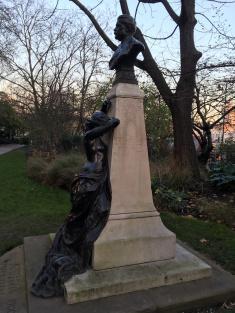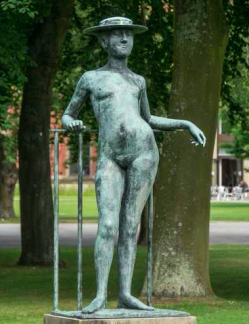Having s

een
this blog floating around social media the past couple of days I finally broke and had a minor tweet rant yesterday. Apparently, I am not done. So here is a blog of My Thoughts™ on Fearless Girl vs The Bull.First, the fact that Greg Fallis’s blog lays out extra context, for example the SHE inscription, is good (notwithstanding his grating Reasonable Objective Man explaining to you silly people who don’t like history tone). Context and facts are always to be welcomed.That aside, his take is garbage. Here’s why.I spent a weekend last year counting all the statues (925, since you ask) in the UK’s Public Monuments and Statue’s database (ikr). I wrote about it
in full here, but here’s a brief summary:
- Out of 925 statues, only 158 were of women standing alone (the figure for men was 508). If you count group shots, the number of female statues goes up to 253.
- Of the 253 statues of women, 71 were of women who actually existed. The vast majority of these were royal women (the vast majority of those were of Queen Victoria, whose love of erecting statues of herself I have a grudging respect for), with only 25 female statues (remember, out of a total of 925) being of non-royal, historical women. The corresponding figure for men was 498. There were almost twice the number of statues of men called John (43), than there were of non-royal historical women.
- So who were the women? Well, like the statue illustrating this post (a half-naked Euterpe weeping over Sullivan of Gilbert and Sullivan) they are most likely to be allegorical, naked, and only there to provide an adoring foil to your Great Man — Virginia Woolf’s female looking-glass made stone. Failing that, the Virgin Mary is quite popular, as is the good old random naked female, as in this rather fetching “Girl in a Hat” in Birmingham University (which incidentally has a facade that features statues of twelve historical men ranging from Shakespeare to Virgil.)

I will admit to not having counted all the statues in the US, but given the
recent news that every statue in statue-filled Sofia is of a man; given there are more statues of animals in Edinburgh than of women; given in New York’s Central Park there are 22 statues of men and none of women other than fictional characters like Alice in Wonderland; given that women make up less than 30% of speaking roles in Hollywood films; given US congress is
80% male; and, finally, given, you know, just general patriarchy, there is no reason to think the US is a feminist statue Utopia.Greg Fallis may not agree, but all of this is also relevant context to the meaning and importance of Fearless Girl. The vast majority of female statues are of nude sexualised women in the role of adoring muse to male brains (I mean, come on, half naked Euterpe is literally weeping over a male HEAD). The representation of a defiant, clothed, non-sexualised female in a prominent work of art is still vanishingly rare — and is therefore a radical act no matter who commissioned it and what the artistic intent was.Which leads me on to the second garbage take. Greg Fallis says, and I quote,
Fearless Girl also changes the meaning of Charging Bull. Instead of being a symbol of “the strength and power of the American people” as Di Modica intended, it’s now seen as an aggressive threat to women and girls — a symbol of patriarchal oppression.
No, Greg. Just, no. Like many other men, Di Modica may not realize that rampant male-dominated capitalism already is a symbol of patriarchal oppression, already is an aggressive threat to women and girls all around the world, but that doesn’t make it any less the case. Here in the UK, women have repeatedly been found to bear the
major brunt of the austerity policies that have been considered necessary to wipe up the mess to the global economy caused by these very same bankers. Last year,
the UN charged Switzerland with failing its obligations under the Convention for the Elimination of All Forms of Discrimination Against Women (CEDAW), specifically because of their laissez-faire banking policies. of which Wall Street bankers makes such great use. I’m not going to go into a full-on lecture on feminist economics here, but if you’re interested, read anything by Nancy Folbre and you can’t go wrong. But to be clear: rampant unchecked capitalism is a symbol of patriarchal oppression whether Di Modica likes it or not. Fearless Girl does not therefore change the meaning to Charging Bull. She makes it explicit. And for that, I love her.Di Modica wanted to represent “the strength and power of the American people”. I don’t want to be pedantic here, but to do this, he chose a bull. A male cow. Di Modica chose to represent the American people with an animal that is perhaps above all others considered a byword for male sexual aggression. And my god the balls on that thing. I think we can be fairly certain how Di Modica visualises power and strength — the phrase “grow a pair” comes to mind. Let’s be clear: this statue never represented the strength and power of American people. It represented the strength and power of American men.And this leads me on to my final grips with Fallis’s blog: the idea that artistic intent should or even can be the last word on how a statue is interpreted. I’m tempted at this point to tell everyone making this facile point to go and read Barthes’ The Death of the Author but that’s the kind of thing a wanker would do and I, madam, am no wanker. Instead, I will say this. Di Modica may not like the fact that his underlying message of male supremacy has been highlighted, but he doesn’t get to dictate how his art is interpreted any more than the investment fund that commissioned Fearless Girl does. Sure, they can stick their “SHE” gender diversity index plinth on there. But that isn’t going to make a blind bit of difference to how the vast majority of passers-by will interpret and react to the statue: which is the simple point of a girl standing up to a rampaging bull. I maintain that anyone who sees that and doesn’t rejoice, even a little bit, in their hearts, is dead inside.Di Modica chose to represent the strength and power of the American people with an intensely male and sexually aggressive symbol. Now he doesn’t like that Fearless Girl is, essentially, calling him out on it. Well. Welcome to the 21st century, Di Modica. You’re going to be seeing an awful lot more of this kind of thing.
 een this blog floating around social media the past couple of days I finally broke and had a minor tweet rant yesterday. Apparently, I am not done. So here is a blog of My Thoughts™ on Fearless Girl vs The Bull.First, the fact that Greg Fallis’s blog lays out extra context, for example the SHE inscription, is good (notwithstanding his grating Reasonable Objective Man explaining to you silly people who don’t like history tone). Context and facts are always to be welcomed.That aside, his take is garbage. Here’s why.I spent a weekend last year counting all the statues (925, since you ask) in the UK’s Public Monuments and Statue’s database (ikr). I wrote about it in full here, but here’s a brief summary:
een this blog floating around social media the past couple of days I finally broke and had a minor tweet rant yesterday. Apparently, I am not done. So here is a blog of My Thoughts™ on Fearless Girl vs The Bull.First, the fact that Greg Fallis’s blog lays out extra context, for example the SHE inscription, is good (notwithstanding his grating Reasonable Objective Man explaining to you silly people who don’t like history tone). Context and facts are always to be welcomed.That aside, his take is garbage. Here’s why.I spent a weekend last year counting all the statues (925, since you ask) in the UK’s Public Monuments and Statue’s database (ikr). I wrote about it in full here, but here’s a brief summary:
